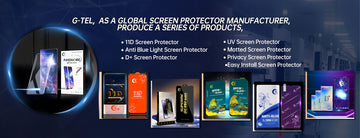How to Make a Tempered Glass Screen Protector-G-Tel Glass Factory
How to Make a Tempered Glass Screen Protector?
Making a tempered glass screen protector involves multiple precise manufacturing steps to ensure the product is durable, clear, and fits perfectly on a smartphone screen. Below is a step-by-step breakdown of the process:
1. Material Selection
The process begins with selecting the right type of glass. High-quality materials ensure the durability and clarity of the screen protector.
- High-Alumina Glass: Known for its hardness and scratch resistance, this type of glass is commonly used for premium screen protectors.
- Soda-Lime Glass: Used in more budget-friendly options but still provides decent protection.
2. Cutting and Shaping
The glass sheets are cut and shaped into the dimensions required for specific smartphone models.
-
Precision Cutting:
- Advanced CNC (Computer Numerical Control) machines are used to cut the glass with extreme precision.
- The cutting process includes creating exact measurements for the screen's dimensions, camera holes, and other sensor cutouts.
-
Edge Design:
- The edges of the glass are smoothed and rounded using tools to create 2.5D or 3D curved edges, ensuring they are safe to handle and fit snugly on curved screens.
3. Tempering Process
Tempering is the key process that gives the glass its strength and durability.
-
Heating:
- The glass is heated to a temperature of around 600-650°C in a specialized furnace.
-
Rapid Cooling:
- After heating, the glass undergoes rapid cooling using high-pressure air jets. This step creates a compressive force on the glass’s surface while leaving the core in tension, making the glass more resistant to impacts and scratches.
4. Surface Treatment
To enhance the glass’s functionality and appearance, various coatings are applied.
-
Oleophobic Coating:
- A thin layer of oil-resistant material is applied to make the surface resistant to fingerprints, smudges, and oil. This also enhances the smoothness of the protector.
-
Anti-Reflective Coating (Optional):
- Reduces glare and ensures better visibility under bright light conditions.
-
Anti-Blue Light Coating (Optional):
- Filters out harmful blue light to protect the user’s eyes during prolonged screen time.
-
Privacy Layer (Optional):
- A specialized coating narrows the viewing angle, providing privacy by making the screen visible only from a direct angle.
5. Adhesive Layer Application
A silicone-based adhesive layer is applied to the back of the tempered glass to enable secure and bubble-free attachment to the phone screen.
-
Precision Application:
- The adhesive is applied evenly across the entire surface or only along the edges (depending on the type of screen protector, such as full-glue or edge-glue).
-
Micro-Air Channels:
- Some manufacturers, like G-Tel Glass Factory, incorporate micro-air channels in the adhesive layer to allow air bubbles to escape during installation.
6. Testing and Quality Control
Each tempered glass protector undergoes rigorous testing to ensure it meets quality standards.
-
Hardness Testing:
- The glass is tested to ensure it achieves a 9H hardness rating, making it resistant to scratches from sharp objects like keys and knives.
-
Impact Resistance:
- Drop tests are conducted to check the glass's ability to absorb shocks without breaking.
-
Transparency Testing:
- High-end protectors are tested for clarity, ensuring the glass has a transparency rate of 92-98% to maintain the screen’s original display quality.
-
Touch Sensitivity:
- The protectors are evaluated to ensure they do not interfere with the touch responsiveness of the screen.
7. Finishing and Packaging
The final step involves preparing the tempered glass protector for sale.
-
Cleaning:
- The glass is thoroughly cleaned to remove any particles or residues.
-
Dust-Free Packaging:
- The protector is packed in a dust-free environment and includes installation kits like cleaning wipes, dust stickers, and microfiber cloths to aid users during installation.
-
Labeling and Branding:
- Product details, brand logos, and certifications (e.g., CE, RoHS) are added to the packaging.
Advanced Technologies Used by G-Tel Glass Factory
G-Tel Glass Factory, a leader in screen protector manufacturing, employs state-of-the-art technology to produce high-quality tempered glass protectors. Their processes include:
- Precision CNC Cutting for exact fits on various smartphone models.
- Anti-Fingerprint and Anti-Blue Light Coatings to enhance user experience.
- Advanced Tempering to ensure high durability and shatter resistance.
- Automated Quality Control Systems to ensure every piece meets international standards.
Conclusion
The process of making a tempered glass screen protector is a combination of advanced engineering, precision manufacturing, and rigorous testing. From selecting premium materials to applying protective coatings and ensuring a perfect fit, manufacturers like G-Tel Glass Factory deliver products that offer excellent durability, clarity, and ease of installation. By choosing a screen protector made with advanced technology, users can protect their smartphones effectively while maintaining an optimal viewing experience.
Contact Us
Email: sales@gtelglass.com
WhatsApp: +86 18038664849
Phone: (+86) 18038664849
Working Time:(CST), UTC +8 6a.m to 10p.m.
Headquarters Address:
#436 4Floor,New Asia International Digital Electronic City Building, Xidi Erma Road, Liwan District, Guangzhou, Guangdong Province, China.


